 |
 |
 |
 |
 |
 |
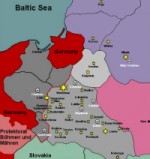 |
| Ghettos |
The Jewish community was already established in the 16th Century. Most of the Jews lived around the Market Square. Before WW2 about 6.000 - 7.000 Jews resided in the town, where they represented 56% of the total inhabitants. The town was a typical Galician shtetl. However, representatives of modern Jewish intelligentsia also lived in Rawa and some Jewish families were assimilated into the Polish cultural milieu.
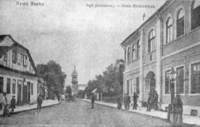 |
| Pre-War Rawa Ruska |
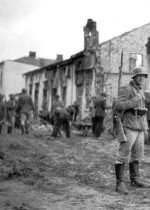 |
| Forced Jews |
In mid-July 1941 a Judenrat was established with Wastenberg as its president. At this time there was no closed ghetto in Rawa Ruska. Jews could live anywhere in the town as in pre-war days.
In August the Germans demanded monetary contributions from the Jews of Rawa Ruska. The advocate Dr Jozef Mandel opposed the Germans' orders and refused to give them both the people for forced labour and the money they requested. Members of the SD from Sokal arrived in Rawa and arrested 15 members of the Jewish intelligentsia, as well as Dr Mandel. He was taken out of town at night since the Germans were afraid that the population would resist such action. As a hostage, Mandel was brought to Krakow where he was arrested in the notorious Gestapo prison on Montelupich Street. The same month a bag of food was sent to him by his niece Erna Weinberger née Hartel from Gorlice. Dr Mandel died there from Typhus in (possibly) December 1941.
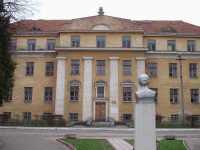 |
| Kriminalpolizei HQ today |
The first "action" in Rawa was organized at the end of March 1942. SD men from Sokal arrived in the town and, with the help of Ukrainian police, and in accordance with a special list, arrested about 1,000 Jews, who were gathered in the square before the Kripo office in the centre of the town. Everything was done without brutality. The arrested people – mainly elderly men and women - did not know why they had been gathered together and what the future held for them. The same day the deportees were led to the railway station and loaded onto a train; 100 Jews in every cattle car. All of them were deported to Belzec.
From the beginning of 1942 the Jews in Rawa heard rumours about the construction works in Belzec. They understood that the Germans were building some kind of camp but nobody knew of what nature.
During the first days after the deportation the Jews who were left in Rawa did not know about the fate of the deportees. It was only afterwards that an 80 year old woman who had been hidden in a latrine on the camp grounds returned to the town and told of the fate of the whole transport, and that a death camp for Jews was in Belzec.
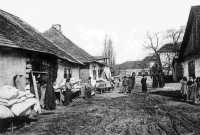 |
| Jewish Quarter #1 |
By that time the Jews in Rawa knew everything about the camp. They knew that there were gas chambers and that thousands of Jews had already been murdered there. "Everybody knew but nobody spoke about it. We knew that nobody returned from there," wrote Wolf Sambol, one of the survivors from Rawa.
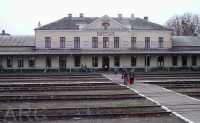 |
| Railway Station today |
"These newcomers from the trains were called "jumpers" by us. Every day the Jews from Rawa gathered the bodies of killed "jumpers” which were transported in horse wagons to the Jewish cemetery. Here they were buried in mass graves. The German authorities did not know about the "jumpers" in our town. The Jewish inhabitants hid them in cellars. We estimated that there were about 2,000 "jumpers" in Rawa."
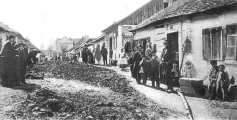 |
| Jewish Quarter #2 |
SS man Grzimek, who earlier had been an SS officer at the Janowska camp in Lviv (Lwow), organized this "action". He ordered the Judenrat to organize a larger unit of Jewish police – shortly before this "action" there were a total of 50 Jewish policemen in Rawa. On 7 December 1942 the SS men, Ukrainian and Jewish policemen started to search every house in the ghetto. Many people tried to hide sick members of their families, as special bunkers had been built in every house. In numerous cases people passively awaited their fate in their rooms. The Germans and Ukrainians shot many Jews on the spot – in the houses, even in their beds. During the four days of the "action" the Jews were gathered in the building of the synagogue and in several wooden sheds. They were sent to the railway station and from there deported to Belzec. In the square between the synagogue and the Beth Midrash drunken German and Ukrainian policemen shot many people. Approximately 6,000 - 7,000 Jews were deported to the death camp. It is not known how many Jews were killed in the ghetto. The December deportations from Rawa were probably the last transports that were sent to Belzec.
During the "action" the SS men and members of the Kripo from Rawa (Spätt, Klein, Trägner and Meiert) organized selections. Young men and women, fit to work, were selected and sent to the small work camps located around Rawa: Kamionka and Rata. A substantial group of the people who were selected in December 1942 were sent to the Janowska camp in Lviv (Lwow).
A sizeable body of Jews was left in Rawa and they worked at cleaning the empty Jewish houses in the ghetto. A smaller party of Jews called the "Death Brigade" was chosen from among this group. Their duty was to gather the bodies of those killed during the "action". The bodies were buried in a mass grave at the Jewish cemetery. When they finished their "work", Grzimek gathered them together in one house in the ghetto and setting the building ablaze, burned them alive.
At the beginning of March 1943 there were officially only 100 Jews left in the ghetto but there were more people in hiding places within many of the houses. It has been estimated that there was perhaps a total of 350 - 400 Jews in the ghetto. SS-Hauptsturmführer Pressmann who, according to survivors, was more "human", replaced Grzimek. Pressmann lived in a house in the ghetto area and never personally killed any Jew. But during his turn of duty in Rawa, the Kripo organized the hunting in the ghetto of the so-called "illegal" Jews.
An underground group was then organized in the ghetto. The Jewish partisans, whose commander was Auerbusch, made contact with Soviet partisans near Rawa and bought weapons from the peasants. The Jewish partisans prepared to fight in the event of the final liquidation of the ghetto. However, this act of resistance never occurred, since some members of the group decided to escape from the ghetto. When they were at the Catholic cemetery a peasant denounced them. The Germans killed them there. Before his death, one of the Jews told about the entire organisation. German policemen arrested the commander and executed him.
The final liquidation of the ghetto took place on 8 June 1943. Before the "action" the Germans organized another piece of chicanery. They ordered the gathering of a "contribution" of 100.000 zlotys as surety for the survival of the inmates of the ghetto. They claimed that all Jews from Rawa would be sent to the work camps in Potylicz and Rata, including both "legal" and "illegal" Jews. The people believed this and paid the "contribution". When the money had been collected, all of the people in the ghetto were gathered together. Next day all of them were executed in the forest near Rawa.
Only a few Jews from Rawa survived - those who had escaped from the ghetto before the "actions". Local Poles in Rawa Ruska hid some of them. Bazyli Chmielewski who rescued two Jewish families, some 9 people, organized one of the biggest shelters in Rawa Ruska. After the war he lived in Lublin and was decorated by Yad Vashem. He died in Lublin in 2004, almost 90 years of age.
The territory of the ghetto in Rawa was totally destroyed. All of the houses were burned and at this place today there are only new, unsightly Soviet-style blocks of apartments. The Jewish cemetery was demolished and only a few tombstones have survived. There is no memorial in Rawa Ruska, neither where the ghetto once stood nor at the Jewish cemetery.
Sources:
The testimonies by survivors from Rawa Ruska deposited in the Jewish Historical Institute.
Interview with Mr. Bazyli Chmielewski in the private archive of R. Kuwalek.
Interviews with the former Polish inhabitants of Rawa Ruska in Belzec Memorial Museum.
Yosef (Mandel) Shaked
 |
| 15,000 Jews lived in the ghetto |
© ARC 2005